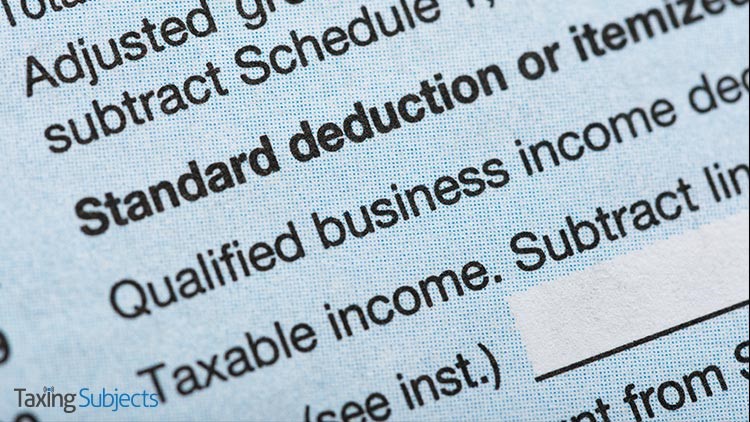by | Sep 27, 2019 | Tax Tips and News
Taxpayers interested in taking the section 199A qualified business income deduction (QBI) for their rental property will be happy to learn that the IRS announced a finalized safe harbor rule this week.
QBI was introduced in the Tax Cuts and Jobs Act as tax relief for businesses not eligible for the new 21-percent C corporation tax rate. According to the IRS fact sheet, owners of passthrough entities can “deduct up to 20 percent of their qualified business income (QBI), plus 20 percent of qualified real estate investment trust (REIT) dividends and qualified publicly traded partnership (PTP) income.” For new deductions like QBI, safe harbor accounting methods can help address uncertainty.
A safe harbor is essentially an IRS-defined set of guidelines that taxpayers can follow when determining eligibility for complicated tax benefits. If the subject of the tax benefit falls within that set of parameters, the IRS will not challenge the position taken on the tax return. To claim the QBI safe harbor for rentals, the IRS says the rental property must tick all of these boxes:
- Separate books and records are maintained to reflect income and expenses for each rental real estate enterprise.
- For rental real estate enterprises that have been in existence less than four years, 250 or more hours of rental services are performed per year. For other rental real estate enterprises, 250 or more hours of rental services are performed in at least three of the past five years.
- The taxpayer maintains contemporaneous records, including time reports, logs, or similar documents, regarding the following: hours of all services performed; description of all services performed; dates on which such services were performed; and who performed the services.
- The taxpayer or RPE attaches a statement to the return filed for the tax year(s) the safe harbor is relied upon.
Even if the rental falls short of the safe harbor requirements, the IRS reminded taxpayers that they may still be able to claim the QBI deduction—though the process won’t be as clear cut.
To learn more about the finalized QBI safe harbor rules, review Revenue Procedure 2019-38 and the IRS web page on tax reform.
Sources: IR-2019-158; FS-2019-8
– Story provided by TaxingSubjects.com
by | Sep 26, 2019 | Tax Tips and News
While current weather patterns point to an active hurricane season, the IRS wants taxpayers to know that disaster assistance and tax relief measures are in place should a natural disaster strike.
Before the Internal Revenue Service can authorize tax relief, though, the president has to declare the event a federal disaster. Once that occurs, tax relief measures can be set in motion.
Here’s a few of the tax tools taxpayers may be granted in a federally declared disaster.
More Time to File and Pay
Taxpayers located in a disaster area may receive extra time to file returns and pay taxes. The IRS Twitter account and disaster assistance page provide disaster updates and links to resources. Taxpayers can also call the IRS disaster line at 866.532.5227.
Qualify for a Casualty Loss Tax Deduction
People whose property was damaged or lost in a federally declared disaster may qualify to claim a casualty loss deduction. They can claim this on their current or prior-year tax return and may get a larger refund. The IRS says it will process these returns quickly.
File for a Disaster Loan or Grant
The Small Business Administration offers financial help to business owners, homeowners, and renters in a federally declared disaster area. To qualify, a taxpayer must have filed all required tax returns.
Request a Tax Return Transcript
People affected by a disaster can get copies or transcripts of past tax returns for free by submitting one of two forms. These are Form 4506, Request for Copy of Tax Return, and Form 4506-T, Request for Transcript of Tax Return. The taxpayer should state on the form the request is related to a disaster. They should also list the state and type of event to help speed up the process.
Submit a Change of Address
After a disaster, taxpayers who might need to temporarily relocate should notify the IRS about their new address by submitting Form 8822, Change of Address.
The IRS encourages affected taxpayers to review all federal disaster relief by visiting disasterassistance.gov.
Additional Resources
The IRS has a number of other resources that can help map a course of action after a natural disaster:
Reconstructing records after a disaster
Tax relief in disaster situations
Around the nation
FAQs for disaster victims
Publication 2194, Disaster Resource Guide for Individuals and Businesses
Publication 584, Casualty, Disaster, and Theft Loss Workbook
Publication 584-B, Business Casualty, Disaster, and Theft Loss Workbook
– Story provided by TaxingSubjects.com
by | Sep 13, 2019 | Tax Tips and News
IRS Tax Tip 2019-126, September 12, 2019
Tax professionals should review their security measures and create a data theft recovery plan. This plan can help save valuable time and protect tax professionals and taxpayers after a data theft (PDF) . One of the first things a preparer should do after a theft is contact the IRS. Here are other steps tax pros should outline in their plan:
Contact the IRS and law enforcement:
- Report client data theft to the local IRS Stakeholder Liaison. They will notify IRS Criminal Investigation and other appropriate offices within the agency on behalf of the preparer. Speed is critical. If reported quickly, the IRS can take steps to block fraudulent returns in a preparer’s clients’ names.
- Local Federal Bureau of Investigation.
- Local police and file report on the data theft.
Contact state agencies where they prepare state returns:
- State Tax Agencies. Email the Federation of Tax Administrators at StateAlert@taxadmin.org to get information on how to report victim information to the states.
- State Attorneys General. Most states require that the attorney general be notified of data thefts. This process may involve contacting multiple offices.
Contact experts:
- Security expert. They can determine the cause and scope of the theft. They can also figure out how to prevent further losses.
- Insurance company. Preparers should check to see if their insurance policy covers expenses related to the data loss.
Contact clients and other services:
- Federal Trade Commission. They offer tips and templates for businesses that suffer data compromise. They even have suggested language for informing clients.
- Clients. Send a letter to victims letting them know about the theft. Preparers should work with law enforcement on timing. A preparer who has prior-year data in their system may need to contact former clients.
- Tax software provider. They may need to take steps to prevent inappropriate use of the compromised account for e-filing.
- Website and client portal provider. Thieves may have stolen passwords. The preparer and provider would need to reset these.
- Credit and identity theft protection agency. Certain states require credit monitoring and identity theft protection to victims of ID theft.
- Credit bureaus. Notify them if there’s a compromise. The preparer’s clients may seek their services.
Subscribe to IRS Tax Tips
– Story provided by IRS Tax Tips
by | Sep 12, 2019 | Tax Tips and News
For some taxpayers paying estimated taxes who have filed their 2018 tax returns there’s a little bit of bad news—and some good news.
The bad news is they failed to claim the special waiver that would have spared them from the estimated tax penalty mandated when withholding and estimated tax payments fell short of their total tax liability.
The good news is the IRS is granting the waiver automatically and will refund any penalty payments eligible taxpayers made. There’s no need to contact the IRS to request the waiver.
How Did That Happen?
Earlier this year, the IRS lowered the usual 90% penalty threshold to 80% to help taxpayers whose withholding and estimated tax payments fell short of their total 2018 tax liability. The agency also removed the requirement that estimated tax payments be made in four equal installments, as long as they were all made by Jan. 15, 2019.
The 90% threshold was initially lowered to 85% on Jan 16 and further lowered to 80% on March 22.
About 400,000 taxpayers will qualify for the automatic waiver, which applies to any individual who paid at least 80% of their total tax liability through withholding or quarterly estimated tax payments but did not claim the special waiver when they filed their 2018 return earlier this year.
“The IRS is taking this step to help affected taxpayers,” said IRS Commissioner Chuck Rettig. “This waiver is designed to provide relief to any person who filed too early to take advantage of the waiver or was unaware of it when they filed.”
Refunds Planned for Qualified Taxpayers
Over the next few months, the IRS will mail copies of notice CP21 granting this relief to affected taxpayers. Any eligible taxpayer who already paid the penalty will also receive a refund check about three weeks after their CP21 notice regardless if they requested penalty relief.
The IRS stresses that eligible taxpayers who have already filed a 2018 return do not need to request penalty relief, contact the IRS or take any other action to receive this relief.
For those taxpayers who have yet to file, eligible taxpayers are urged to claim the waiver on their return. This includes taxpayers with filing extensions due to run out on Oct. 15, 2019.
The quickest and easiest way is to file electronically and take advantage of the waiver computation built into their tax software package. Those who choose to file on paper can fill out Form 2210 and attach it to their 2018 return. See the instructions to Form 2210 for details.
Check That Withholding
Like last year, the IRS urges everyone to do a “Paycheck Checkup” and review their withholding for 2019. This is especially important for anyone who faced an unexpected tax bill or a penalty when they filed this year. It’s also an important step for those who made withholding adjustments in 2018 or had a major life change.
To get started, check out the new Tax Withholding Estimator, available on IRS.gov. More information about tax withholding and estimated tax can be found on the IRS’ Pay As You Go web page, as well as in Publication 505.
– Story provided by TaxingSubjects.com
by | Sep 11, 2019 | Tax Tips and News
Owning your own business can be a very rewarding experience. The process of starting a business, however, can seem overwhelming to the uninitiated. There are so many choices to consider – from business plans to market strategies and tax responsibilities.
The IRS has put together a quick list of items any new owner of a business will have to determine. While the list may be the most benefit to first-time business owners, it can help owners of any new enterprise get off to a good start.
- Choose a business structure. The form of business determines which income tax return a business taxpayer needs to file. The most common business structures are:
- Sole proprietorship: An unincorporated business owned by an individual. There’s no distinction between the taxpayer and their business.
- Partnership: An unincorporated business with ownership shared between two or more people.
- Corporation: Also known as a C corporation. It’s a separate entity owned by shareholders.
- S Corporation: A corporation that elects to pass corporate income, losses, deductions, and credits through to the shareholders.
- Limited Liability Company: A business structure allowed by state statute.
- Choose a tax year. A tax year is an annual accounting period for keeping records and reporting income and expenses. A new business owner must choose either:
- Calendar year: 12 consecutive months beginning January 1 and ending December 31.
- Fiscal year: 12 consecutive months ending on the last day of any month except December.
- Apply for an employer identification number. An Employer Identification Number or EIN is also called a federal tax identification number. It’s used to identify a business. Most businesses need an EIN.
- Have all employees complete these forms:
- Form I-9, Employment Eligibility Verification
- Form W-4, Employee’s Withholding Allowance Certificate
- Pay business taxes. The form of business determines what taxes must be paid and how to pay them.
Taxpayers interested in starting a business can find information for some industries on the IRS’ Industries/Professions Tax Centers webpage. Each state has additional requirements for starting and operating a business. Prospective business owners should visit their state’s website for info about state requirements.
More information may also be found on the Small Business Administration’s web page 10 Steps to Start Your Business.
– Story provided by TaxingSubjects.com




